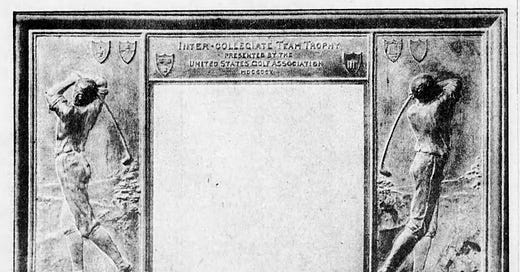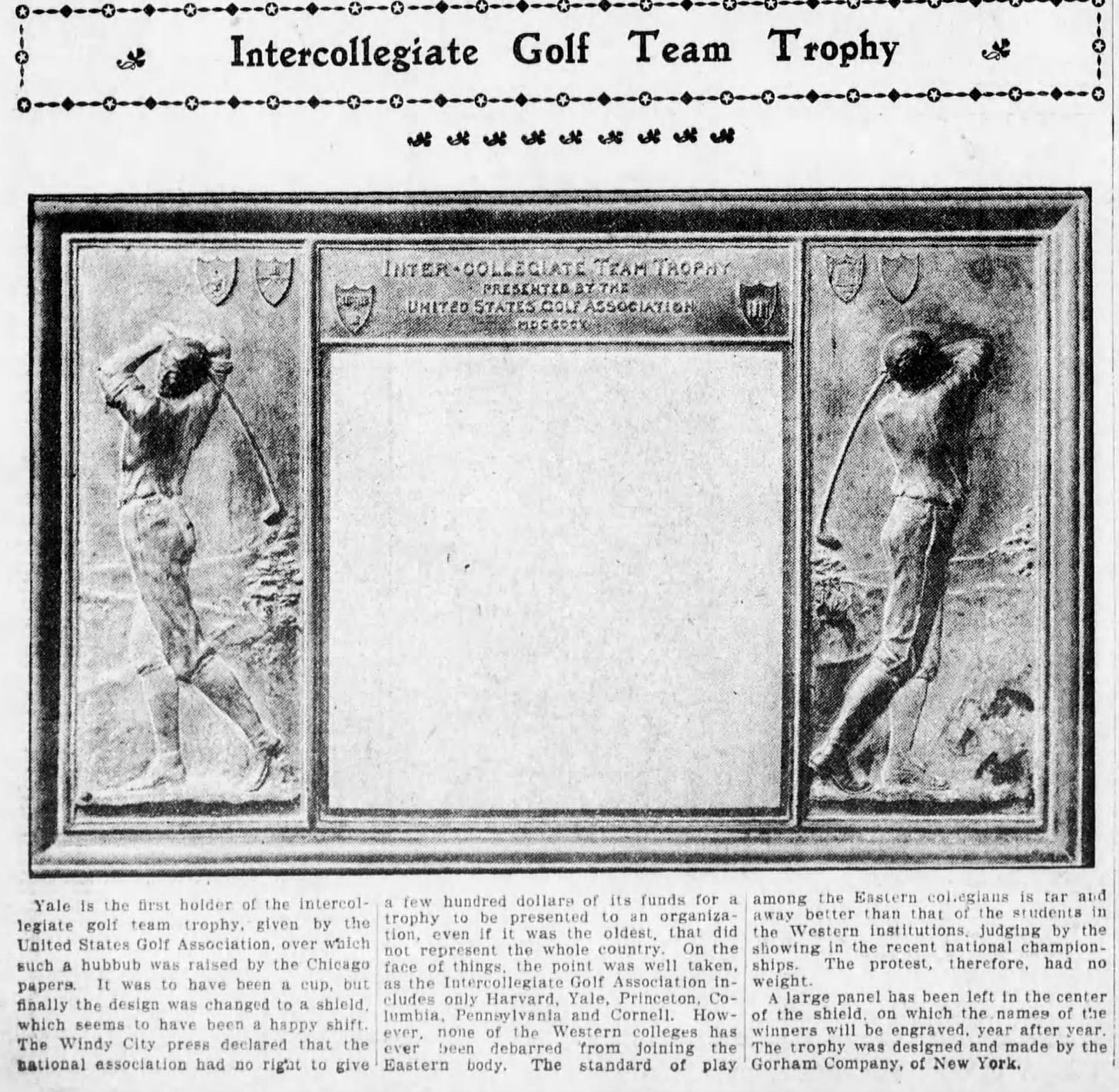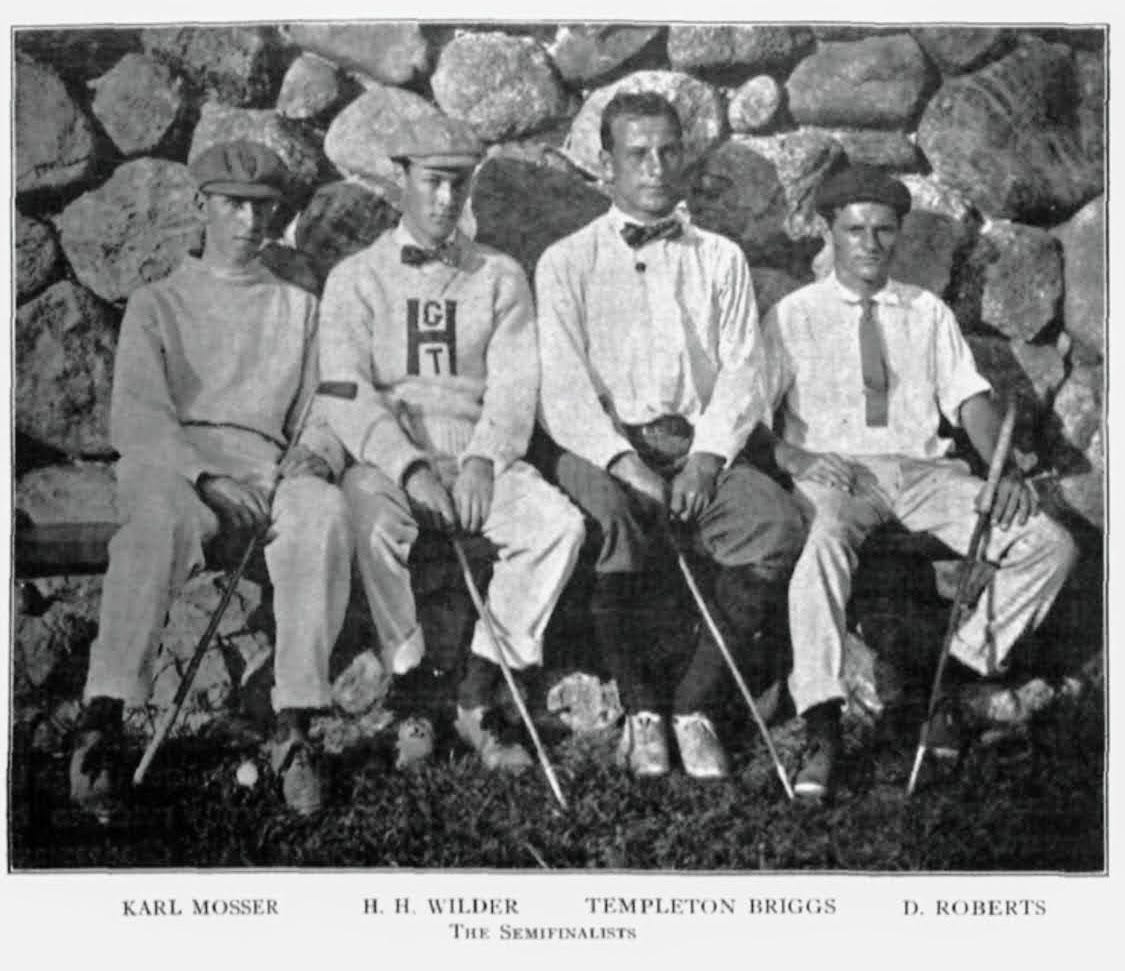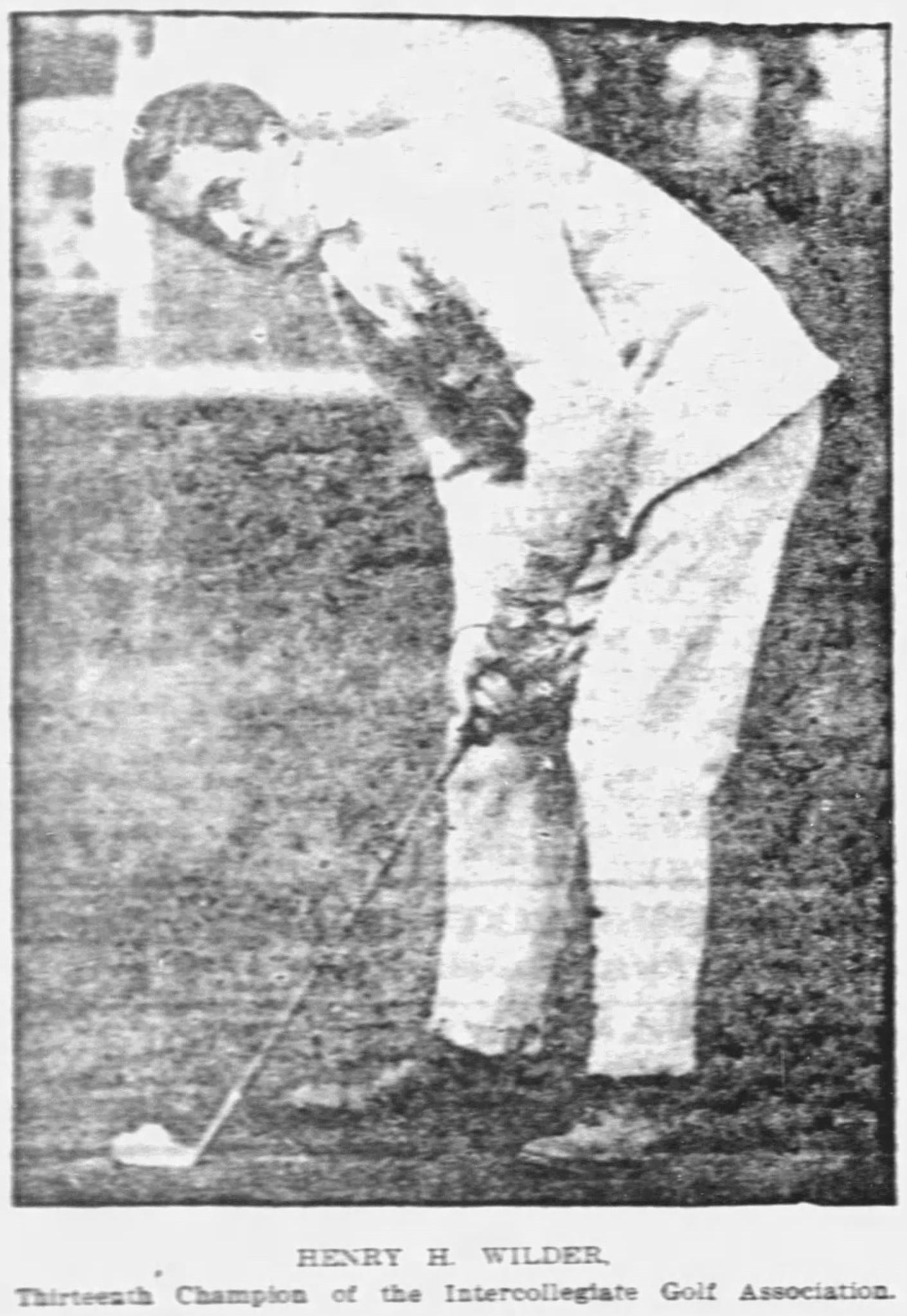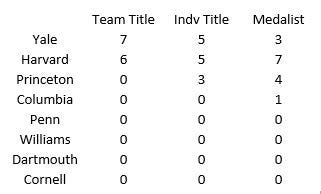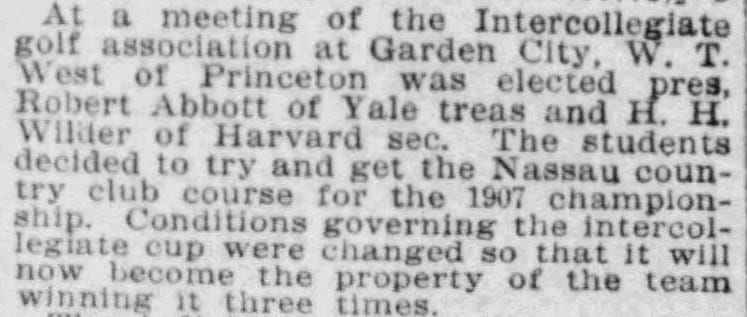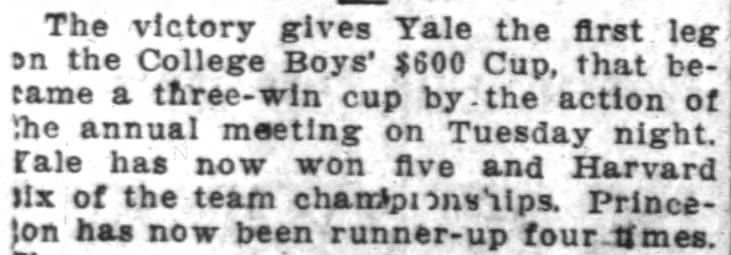This is part of a series on the Men’s Collegiate Championships
IGA Championship Era: 1897-1938
More Teams: Absorbing the NEIGA
Back in May, 1903, several of the New England area colleges got together to form their own Intercollegiate Golf Association (NEIGA) and later that year the first championship was held at Wannamoisett. The teams - Amherst, Bowdoin, Brown, MIT, Williams, and Dartmouth - would continue the tournament through 1907. This year (1908) the NEIGA was effectively dissolved and merged into the IGA although the latter two teams were the only ones to join the organization. The IGA now had 8 member teams: the five original, Cornell (joined in 1903 but only team appearance so far in 1906), Williams, and Dartmouth. Interesting side note: Syracuse had actually made a petition to join the association as well in 1907 but was dropped without ever participating.
More Team Golf: New Team Format
This tournament is the first to make a significant change in the team match play format by adding a four-ball element to the mix. Additionally, after years of trying to tweak the point value of any given match, the IGA finally simplified the results by making each match worth 1 point to go towards the team total. Although there would be one more slight change to the order played, this is the format that would remain until WWI interrupted the tournament. The format:
Six (6) single matches worth 1 point each
Three (3) four-ball matches worth 1 point each
**Note that these matches were no longer based on net holes won, but rather traditional match play scoring, just like the individual matches.
Intercollegiate Championship #13: Oct 5-10, 1908
Host: Brae Burn CC (West Newton, MA)
The Boston-area club hosts for the first time. Many significant championships would be played at the course over the years including men’s and women’s US Amateurs, a US Open (won by Walter Hagen), and multiple Curtis Cup matches.
Format
Team match play (4 teams, 6 players each, random draw)
New scoring format with 9 total points up for grabs to determine the team winner, used for the Semifinal matches
**FOR SOME UNKNOWN REASON they decided to try Nassau scoring just for these Finals so that each of the 9 matches (6 single, 3 four-ball) would be worth 3 points, for a total of 27:
1 point for winning the front 9
1 point for winning the back 9
1 point for winning the overall match
Individual stroke play qualifier (36 holes)
Because only 4 of the 6 expected teams showed up, they used the extra day to play a 36 hole qualifier for the first time
Individual match play (16 players, *specified seeding)
Appears to be the first time that seeding was used:
1 vs 9, 5 vs 13, 7 vs 15, 3 vs 11, 4 vs 12, 8 vs 18, 6 vs 14, 2 vs 10
First time the Semifinals was also a 36-hole match, same as the Finals
Results
Team Champ: Yale (7)
Both Harvard and Yale cruised through the first round with 8-1 victories. This was the first time Harvard had been in the Finals since their win in 1904, the last 3 championships had been Yale versus Princeton which by luck of the draw was a first round matchup this year.
The Finals had a slightly different twist with the Nassau-infused scoring, but the results were about as predicted. Yale secured their FOURTH championship in a row by defeating Harvard 14 points to 9, winning first the morning singles 9-6 and then the afternoon 4-ball matches 5-3. Yale’s SEVENTH team title - surpassing Harvard’s six - would prove extra sweet as we’ll see below.
Medalist: Henry H Wilder [Harvard] & JW Coe [Harvard]
Captain of the Harvard team, recent IGA President, and all-around popular player, Henry Wilder was a favorite to win it all, so his finishing as medalist was hardly a surprise. What was unexpected was his teammate, JW Coe, joining him. Both players shot an identical 81-78=159 total. One newspaper suggested that the two planned a playoff for later in the week to determine the “true” medalist, however there are no mentions (yet found) to indicate this happened.
Individual Champ: Henry H Wilder [Harvard]
The individual championship got off to a wild start right out of the gate with Harvard’s Templeton Briggs defeating Princeton’s captain (FH McAdoo) in the morning first round and then Yale’s captain (CE Van Vleck Jr) in the afternoon second round, shooting an astounding 73 (course par, or “bogey”). That total was matched by Wilder in the second 18 of his 36-hole Semifinal match against Yale’s Karl Mosser, however that would be an unofficial score due to a weird circumstance: Wilder was on the 7th green (25th hole of the match) in two but found himself stymied so he took a 4 in match play which halved the hole, however once Mosser’s ball was moved Wilder made the putt for a “medal” score of 3. Why do this? We’re not completely sure, but it’s a fun fact.
Both Harvard men - Wilder and Briggs - advanced through the Semifinals to guarantee the Crimson would equal Yale’s total of 5 individual champions, and in the process snapped an unprecedented streak of Yale players winning the last 3 individual titles. Wilder would handily defeat his teammate 6&5 to become the second man to win both medalist honors and the individual title in the same year, just one year after Yale’s Ellis Knowles accomplished the feat1.
Championship Award Count
EXTRA HOLES: A Tale of Two Trophies
Recall from our last post on the 1904 championship that Harvard’s third win since the new trophy was put into rotation (1902) resulted in a fair amount of drama as the IGA couldn’t figure out for sure if the trophy they purchased at a considerable cost to each member team was a perpetual trophy or one that could be earned/kept just like the Ardsley Cup. It would seem that the infighting got bad enough that the USGA - which had numerous personal and “professional” ties to the IGA (let’s call it a big brother rather than parental relationship at this point) - would step in and offer a lifeline in the form of a donated “trophy” (see the picture at the top of this post) with interesting conditions.
With the USGA’s gift resolving the long-term dispute, the conditions for keeping the existing IGA trophy was finally re-negotiated in 1906, with Yale’s win counting as the first. The win in 1908 meant that the Yale team satisfied the 3-win condition to take ownership of the IGA trophy. In an interesting bit of irony, the fact that it was the fourth win since the huge disagreement over the cup following the 1904 championship meant that Yale actually satisfied the 4-win condition the (Harvard) IGA President had suggested. As of the time of this writing, there has not been any direct mention yet found of Yale taking permanent ownership of the trophy following this tournament, nor is it known if Yale (or anyone else) still possesses it.
BONUS THEORY
More than one newspaper documenting all of this trophy craziness suggested that the IGA should use the opportunity to repurpose the previous team trophy to be a perpetual individual trophy since apparently one was not being given. Details on what happened to this trophy and even what it looked like - described vaguely as a large loving cup without inscriptions - remains unclear, but based on the suggestions and some later photos of individual winners holding loving-style cup(s) in the mid-1930s, there is a chance (though still unlikely) that the IGA team trophy was indeed repurposed. Further clouding matters is the reference to a “42 year old” trophy in 1939 along with a tall, cylindrical trophy seen in photos only from 1937-1939. It may seem like a minor thing, but we are fascinated by these trophies (if that wasn’t obvious) as historical artifacts and are continuing to research their whereabouts. If anyone reading this has more information, please reach out!
Thanks for reading!
Up Next:
In the next post we will cover the 1910 championship which featured a Yale super team to rival the “golden standard” 1904 Harvard squad. The biggest storyline, however, may just be the one player who wasn’t allowed to compete; Chick Evans never had a chance to play college golf but he is without a doubt one of the most impactful individuals in the game’s history.
Since Yale won the team title in 1907, Knowles actually was also the first to earn 3 medals/trophies in the same tournament!

